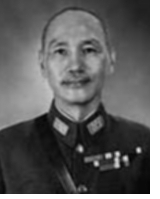Chiang Kai-shek
Head of government in the first Republic of China, b. 31 October 1887 (Chekiang province, China), d. 5 April 1975 (Taipei, Taiwan).
 The son of a moderately prosperous merchant-farmer family, Chiang Kai-shek prepared himself for a military career at the Paoting Military Academy in northern China and from 1907-1909 in Japan. Being impressed by the Japanese military code of honour, he served for two years (1909 - 1911) in the Japanese army. But he also kept contact with Chinese living in Tokio, who were busy planning to replace the discredited Imperial regime by a modern republic. Chiang accepted these revolutionary ideas and became a nationalist revolutionary.
The son of a moderately prosperous merchant-farmer family, Chiang Kai-shek prepared himself for a military career at the Paoting Military Academy in northern China and from 1907-1909 in Japan. Being impressed by the Japanese military code of honour, he served for two years (1909 - 1911) in the Japanese army. But he also kept contact with Chinese living in Tokio, who were busy planning to replace the discredited Imperial regime by a modern republic. Chiang accepted these revolutionary ideas and became a nationalist revolutionary.
When unrest broke out in China in 1911 Chiang returned to his homeland and participated in the overthrow of the old regime. Until 1916 he was active in the struggle for the consolidation of the new Republic, which had been proclamed in 1912 by Sun Yat-sen, but disappeared from public view during 1916-1917. (It is generally believed that he lived in Shanghai as a member of a secret society that occupied itself with financial manipulation.)
Soon after 1912 China had broken up into several independent regions, and Sun Yat-sen's Kuomintang (Nationalist Party) fought a difficult war against a multitude of warlords. In 1918 Chiang joined the Kuomintang, which now received encouragement and assistance from the young Soviet Union. When Sun Yat-sen in 1923 reorganised the Kuomintang into an effective political force, based on the Soviet model, Chiang was sent to the Soviet Union to study its military. On his return he became commandant of a newly organised military academy. He was thus the strongest of all contenders for Sun Yat-sen's succession after his untimely death in 1925 and became the leader of the Kuomintang.
While the Kuomintang based its hopes for a new republic on the educated classes in the cities, the Communist Party, which was founded in 1921 and led by Mao Zedong, considered the rural masses as a revolutionary force. Before Sun Yat-sen's death the two organizations had closely collaborated, and the Kuomintang even had Communist representatives in its central executive committee. Chiang Kai-shek regarded the Communists as a threat to his ambitions for power and tried to eliminate their influence. When this proved difficult he changed to open suppression. In 1927 he massacred the Communist workers who had just liberated Shanghai for him, sealing the break between Kuomingtang and Communists.
In 1928 Chiang's forces entered Beijing (Peking) and Chiang became head of a central Nationalist government. He proclamed social reform, but corruption prevented its implementation. In 1930 Chiang converted to Christianity.
Many warlords still refused to accept the authority of the central government, but Chiang Kai-shek concentrated on fighting the Red Army of the Communists, which promoted social reform in the countryside. In 1931 Japan occupied Manchuria in China's north east and showed signs to invade all of China. War with Japan broke out in 1937, but Chiang still concentrated on fighting the communists. On 12 December 1936, in the so-called "Sian Incident", he was seized by one of his own generals, the commander of Manchuria, and held for 13 days until he agreed to enter a united front with the communist Red Army against Japan.
The united front held until 1945, when Japan surrendered to the USA after suffering the effects of two atomic bombs. Chiang felt that the Japanese threat had disappeared and resumed the civil war against the Red Army. By that time his own army and his government had lost most credibility, and public support of the countryside allowed the Red Army to encircle and capture the cities. In 1949 the People's Republic was declared and Chiang Kai-shek and his troops fled to Taiwan to establish a separatist Republic of China.
The USA considered Chiang's Taiwanese dictatorship a convenient springboard for their opposition to the People's Republic on the mainland and assisted Taiwan with massive injections of capital. In 1955 the USA signed a treaty that guaranteed Taiwan's security. These developments allowed Chiang Kai-shek to transform Taiwan into a modern industrialized country.
In 1979, four years after Chiang Kai-shek's death, the USA terminated diplomatic relations with Taiwan and established diplomatic relations with the People's Republic.
home
 The son of a moderately prosperous merchant-farmer family, Chiang Kai-shek prepared himself for a military career at the Paoting Military Academy in northern China and from 1907-1909 in Japan. Being impressed by the Japanese military code of honour, he served for two years (1909 - 1911) in the Japanese army. But he also kept contact with Chinese living in Tokio, who were busy planning to replace the discredited Imperial regime by a modern republic. Chiang accepted these revolutionary ideas and became a nationalist revolutionary.
The son of a moderately prosperous merchant-farmer family, Chiang Kai-shek prepared himself for a military career at the Paoting Military Academy in northern China and from 1907-1909 in Japan. Being impressed by the Japanese military code of honour, he served for two years (1909 - 1911) in the Japanese army. But he also kept contact with Chinese living in Tokio, who were busy planning to replace the discredited Imperial regime by a modern republic. Chiang accepted these revolutionary ideas and became a nationalist revolutionary.